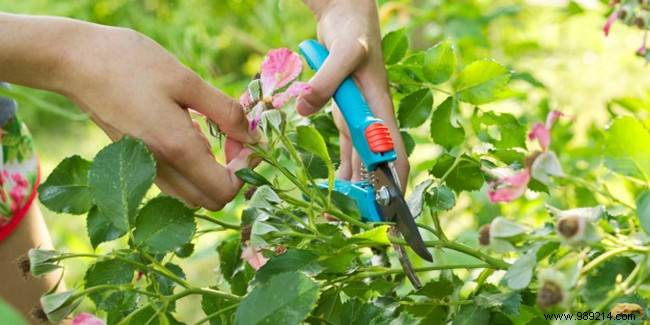
The everything early fall This is the time of year that gardening enthusiasts generally choose to get down to cutting their most beautiful rosebush in order to give birth to other specimens absolutely identical to the mother plant. This mode of vegetative propagation allows you to create clones , which is perfect when you have a few varieties of roses of great splendor flowering in abundance and you want, for example, to create sumptuous beds or border your garden path with this type of plant. Novice gardeners will be delighted to learn that cutting a rose bush poses no particular difficulty as long as the procedure is followed correctly. So here's how to go about it.
Ideally, it is between mid-August and mid-October that roses can be propagated by cuttings. This period is really excellent. However, you can wait until the end of winter if you choose the right time, between February and April. This can be when we get down to pruning roses, for example. We then recover many stems, enough to make several cuttings. The only condition is to choose favorable weather, that is to say when it is not freezing. Choosing the beginning of a rose bush's growth period can be favorable to the resumption of cuttings.
In any case, we recommend that amateurs take cuttings from a rose bush at the very beginning of autumn so that the growth of new shoots starts the following spring. They can in April-May transplant their cuttings in place if they already have good roots and buds have developed.
This technique consists of taking a fragment of a rosebush at the base of which an autonomous root system (or root apparatus) will form. Thanks to cuttings, there is no need to graft the foot on a root belonging to another plant, as is the case with many roses whose rootstock (of the rose hip type, for example) has great resistance and a good ability to adapt to acid soil, for example. Moreover, even today, many amateur gardeners buy grafted roses and are unaware that they can very easily multiply them by cuttings in order to have roses in profusion without breaking the bank.
The roses born from cuttings having roots much less cumbersome than those of a rootstock, they can be planted in pots . It's a great asset if you want to enhance your terrace or balcony with roses, wonderful and divinely scented flowers in most cases.
It may be wise to learn about cuttings using varieties of miniature roses which lend themselves particularly well to this multiplication technique and give such encouraging results that they leave many of us speechless. Thereafter, after having practiced, everything will be possible because you can cut all the roses .
Admittedly, some are a little less easy to propagate than others, but the diligent gardener has no reason to despair. Rather than giving up, just make several cuttings to have a better chance of success, because out of the quantity, there will be one or two that will give birth to a new specimen.
Compliance with the following points is the key to success . This is not complicated in itself, but does require a little rigor. This is how the procedure for cutting a rosebush works .
In the southern regions, it is possible to place the pots containing the rose cuttings in a shady corner of the garden and sheltered from the prevailing winds then cover them with a thick layer of dead leaves to protect them from possible frost.
We can speak of victory when the buds are well swollen and new leaves appear. Of course, 100% success is not guaranteed. The cuttings fail quite quickly, if the leaves dry up or the stem rots. This is why it is useful to take cuttings from several stems, taking care to use a pot for each cutting.
An another method of rose cuttings can be adopted. It is substantially the same as that described above. You simply have to remove the leaves and then make a bevel cut at both ends of the stem of the year measuring a good twenty centimeters. It is then necessary to cut below a bud at the bottom of the stem and above a bud at the top of the stem . We start by planting the cutting upside down then after four weeks, we take the stem out of the substrate with delicacy in order to replant it this time upside down.
Some gardeners use this method of cuttings to promote the healing of the rose stem as well as its rooting. The new plant will need to be transplanted into place during the following spring or fall. The moment has come when you see the roots in the drainage hole of the pot.
In France the legislation only authorizes cuttings for private purposes and exclusively if it is without commercial or professional purposes. This plant propagation technique should therefore not be used indiscriminately. But the goal here is not to create new varieties or even to conduct experiments, or even to get rich by cloning a rose bush under patent. Everyone can, if they wish, read the intellectual property code to find out everything about it (to each their own bedside book!). They will discover there that it is totally forbidden to market its cuttings . We don't just do anything and that's completely normal since behind the varieties of protected roses, there is a creator. The amateur gardener who simply wishes to take cuttings from a few roses to decorate his garden, however, has nothing to worry about.